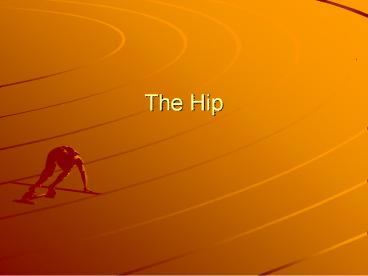The Hip - PowerPoint PPT Presentation
1 / 40
Title:
The Hip
Description:
The Hip Avulsion Fracture Snapping Hip The snapping sensation results from the movement of a muscle or tendon over a bony structure. ITB-When the hip is straight, the ... – PowerPoint PPT presentation
Number of Views:221
Avg rating:3.0/5.0
Title: The Hip
1
The Hip
2
- Femur
- Circumduction
- Acetabulum
- Iliofemoral
- External rotation
- Abduction
- Pubis
- Pubofemoral
- Flexion
- Ilium
- Extension
- Ischiofemoral
- Ischium
- Adduction
- Internal rotation
3
The Hip
- Anatomy
- Injuries
- Evaluation
- Rehabilitation
4
Anatomy
- Bones
- Ligaments
- Muscles
5
Bones of the hip joint
- Femur- The ball part of this bone connects to the
other three bones to comprise the hip joint. - Ilium-This is the largest area of the hip bones.
- Ischium-The ischium is a curved bone which lies
below the ilium. - Pubis-The pubis is the front-most area of the hip
bones. - The ilium, ischium, and pubis come together and
form a cup-like shape that the head of the femur
fits into. This cup is called the acetabulum.
6
(No Transcript)
7
(No Transcript)
8
(No Transcript)
9
(No Transcript)
10
Ligaments
- The iliofemoral ligament attaches the pelvis to
the femur. - The pubofemoral ligament attaches the pubis bone
to the femur. - The ischiofemoral ligament attaches the ischium
to the femur.
11
Motions of the hip
- Flexion and extension
- Abduction and adduction
- Internal and external rotation
- Circumduction
12
Muscles of the hip
- Flexor group
- Extensor group
- External rotators
- Internal rotators
- Abductors
- Adductors
13
Injuries
- Hip flexor strain
- Groin strain
- Hip pointer
- Hip dislocation
- Myositis Ossificans
- ITB syndrome
- Stress Fracture
- Legg-Calve'-Perthes Disease
- Avulsion Fracture
- Snapping Hip
14
Hip Flexor strain
15
Hip flexor strain
16
(No Transcript)
17
Hip pointer
- A hip pointer is an injury is to the iliac crest,
the bony prominence that can be felt along the
waist line. When someone sustains a hip pointer
injury, the bone and overlying muscle can be
bruised.
18
Hip pointer
19
Groin strain
20
Hip dislocation
- It requires substantial force to pop the
thighbone out of its socket. - In nine out of ten hip dislocations, the head of
the thighbone is pushed out and back (posterior
dislocation). This leaves the hip in a fixed
position, bent and twisted in towards the middle
of the body. - http//www.youtube.com/watch?vVrrpgqwxKoE
21
Hip dislocation
22
Hip dislocation
23
Hip dislocation
24
Hip dislocation
25
Myositis Ossificans
- Myositis ossificans is an unusual condition that
often occurs in athletes who sustain a dirtect
blow that causes deep tissue bleeding. - The soft-tissues that were injured in the
traumatic event initially develops a hematoma,
and subsequently develop the myositis ossificans.
- The word myositis ossificans means that bone
forms within the muscle, and this occurs at the
site of the hematoma.
26
Myositis Ossificans
27
ITB syndrome
28
ITB syndrome
- Iliotibial band syndrome is due to inflammation
of the iliotibial band, a thick band of fibrous
tissue that runs down the outside of the leg. - The iliotibial band begins at the hip and extends
to the outer side of the shin bone (tibia) just
below the knee joint. - The band functions in coordination with several
of the thigh muscles to provide stability to the
outside of the knee joint.
29
Stress Fracture
30
Legg-Calve'-Perthes Disease
- LCPD is of unknown origin. It is known that bone
death occurs in the ball of the hip due to an
interruption in blood flow. - The age of diagnosis is usually between 2 and 12
years old, with the average age of 6. - Most of these children are very active and often
very athletic.
31
Legg-Calve'-Perthes Disease
- The first symptoms characterized in LCPD are
usually a limp and perhaps pain in the hip,
groin, or knee (known as a referred pain). - Often you will first notice limping during your
child's active play. - They usually cannot tell you an instance when
they hurt themselves.
32
Legg-Calve'-Perthes Disease
33
Avulsion Fracture
- Causes This injury occurs in sports where
athletes must start and stop running quickly,
must jump, or kick. Such as football, soccer,
and basketball. - Signs and Symptoms You will have sudden pain and
may feel a "pop" in your hip or groin. You may
have trouble moving your hip and leg. The pain is
often worse when the area is touched.
34
(No Transcript)
35
Avulsion Fracture
36
Snapping Hip
- The snapping sensation results from the movement
of a muscle or tendon over a bony structure. - ITB-When the hip is straight, the band is behind
the head of the femur. When the hip bends, the
band moves over the head of the femur so that it
is then front of it. - Tendons-As you bend the hip, the tendon shifts
across the anterior aspect of pelvis when you
straighten the hip, the tendon moves back. - Torn Labrum-If there is a loose flap of cartilage
catching within the joint, this may cause a
snapping sensation when the hip is moved.
37
(No Transcript)
38
(No Transcript)
39
Labral tear
40
Labral tear
- Athletes in sports like hockey, soccer, football,
golf and ballet are at higher risk of developing
a hip labral tear. - Symptoms include hip pain or a "catching"
sensation in your hip joint.































